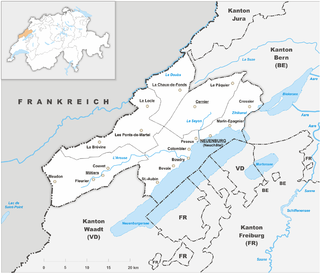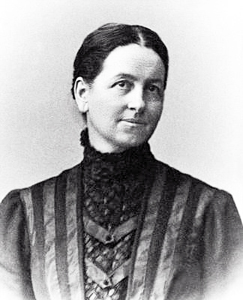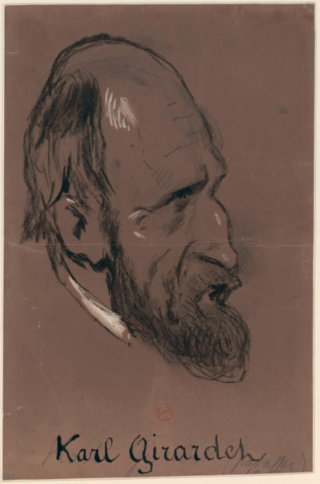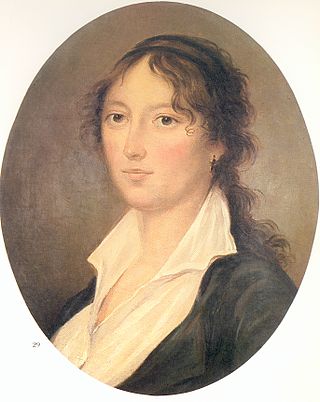
The Republic and Canton of Neuchâtel is a mostly French-speaking canton in western Switzerland. In 2007, its population was 169,782, of whom 39,654 were foreigners. The capital is Neuchâtel.

Neuchâtel is a town, a municipality, and the capital of the Swiss canton of Neuchâtel on Lake Neuchâtel. Since the fusion in 2021 of the municipalities of Neuchâtel, Corcelles-Cormondrèche, Peseux, and Valangin, the city has approximately 33,000 inhabitants. The city is sometimes referred to historically by the German name Neuenburg; both the French and German names mean "New Castle".

Emma Pieczynska-Reichenbach was a Swiss abolitionist and feminist born in Paris, France. She was orphaned at 5 years old, and grew up with foster families in Geneva and Neuchâtel. When she was old enough, she travelled to Paris, where she met and married the intellectual Stanislas Pieczynski. In 1875 she followed him to Poland. Horrified by the lack of education of women there, she began at once to teach reading and writing. In 1881 she turned back to help people in Switzerland. In Leukerbad she learned from the American doctor and suffragette Harriet Clisby, who familiarized her with the women's rights movement.

Le Locle is a municipality in the Canton of Neuchâtel in Switzerland.

The Swiss Guide and Scout Movement (SGSM) (German: Pfadibewegung Schweiz (PBS), French: Mouvement Scout de Suisse (MSdS), Italian: Movimento Scout Svizzero (MSS), Rumantsch: Moviment Battasendas Svizra (MBS)) is the national Scouting and Guiding association of Switzerland formed in 1987. Scouting was founded in Switzerland in 1912 and was among the charter members of the World Organization of the Scout Movement in 1922 and among the founding members of the World Association of Girl Guides and Girl Scouts in 1928. The SGSM has more than 50,500 members in about 550 local groups (as of 2022).

Arnold Reymond (1874–1958) was a Swiss theologian, philosopher (logician) and historian of science.

Karl Girardet was a Swiss painter and illustrator, who lived and worked mostly in Paris. After beginning his career as a landscape painter, he became a renowned history painter as well as a confidant to King Louis Philippe I and an official court painter.

Christophe Moehrlen, pen name: Christoph Irenius, was a Swiss French Protestant pastor of German origin, schoolteacher and author of children's literature.

Anne-Lise Grobéty was a French-language Swiss journalist and an author of short stories, poetry and radio plays.

Auguste Jaccard was a Swiss geologist and paleontologist. His scientific research, for the most part, was associated with the Jura Mountains.

Kids United were a French pop band between 2015 and 2021 that consisted of six, later five, children born between 2000 and 2009. It was created to support UNICEF campaigns and is sponsored by Hélène Ségara and Corneille, two Francophone singers. The first album Un monde meilleur was launched on Universal Children's Day in 2015, it received gold certification in France. The second album Tout le bonheur du monde was certified 2× platinum. It won a Felix Award for best pop album; making it the band's first award.
Marie-Louise Dreier in Brussels is a poet living in Bex in the canton of Vaud, Switzerland.

The Musée des beaux-arts du Locle, located in the canton of Neuchâtel in the Switzerland, organizes temporary exhibitions three times a year. Showcasing prints, photographs, installations and paintings, solo and thematic exhibitions take place in a 2,000 m2 space. These exhibitions of Swiss and international art, past and present, highlight both emerging and established artists. Open to all techniques and mixed media in particular, MBAL also organises the Triennale de l'art imprimé contemporain .
Anne-Marie Martel was a French Roman Catholic woman who gave religious instruction to poor women and children in Le Puy-en-Velay, Haute-Loire. She attracted other women who formed a teaching congregation, which was officially recognized by the church after her death and is now the Congrégation des Sœurs de l’Enfant-Jésus.

Eugénie Droz was a Swiss romance scholar, editor publisher and writer, originally from the Suisse Romande. She created the Librairie Droz, a publisher and seller of academic books, at Paris in 1924, moving the business to Geneva at the end of the war.

Isabelle Morel was a French-speaking Swiss writer, translator and woman of letters who was most notable for her novel Louise et Albert.
Calame is a surname. Notable people with the surname include:

François Perregaux was a Swiss watchmaker and businessman. He was the first European watchmaker to travel to Asia (1863) and is remembered for his contribution to establishing the watchmaking industry in Japan.

Alexandre Girardet was a Swiss engraver, illustrator and watercolorist.

The Le Locle–Les Brenets line is a 1,000 mm railway line in the canton of Neuchâtel in Switzerland. It runs 4.1 kilometres (2.5 mi) from Le Locle, where it has a cross-platform interchange with the standard gauge Neuchâtel–Le Locle-Col-des-Roches line of Swiss Federal Railways, to Les Brenets. The line was originally built by the Régional des Brenets and opened on 1 September 1890. Today, it is operated by the Transports publics Neuchâtelois. On 24 July 2020, the canton of Neuchâtel announced the line will closed in 2025, to be replaced by an electric bus service that will use the Petits-Monts railway tunnel.

















